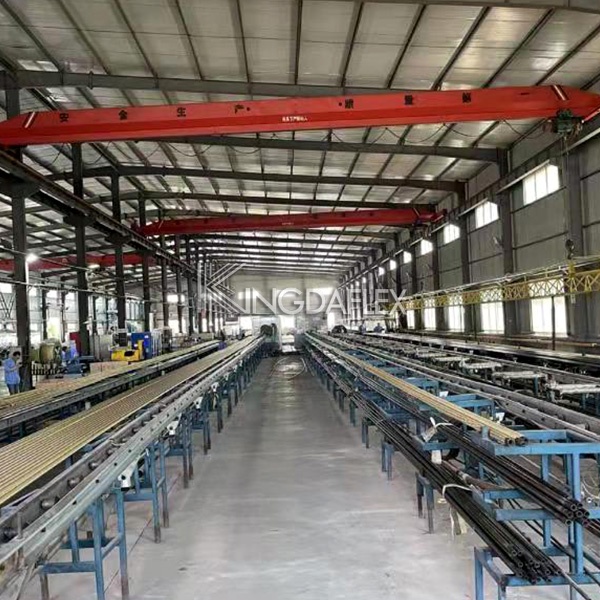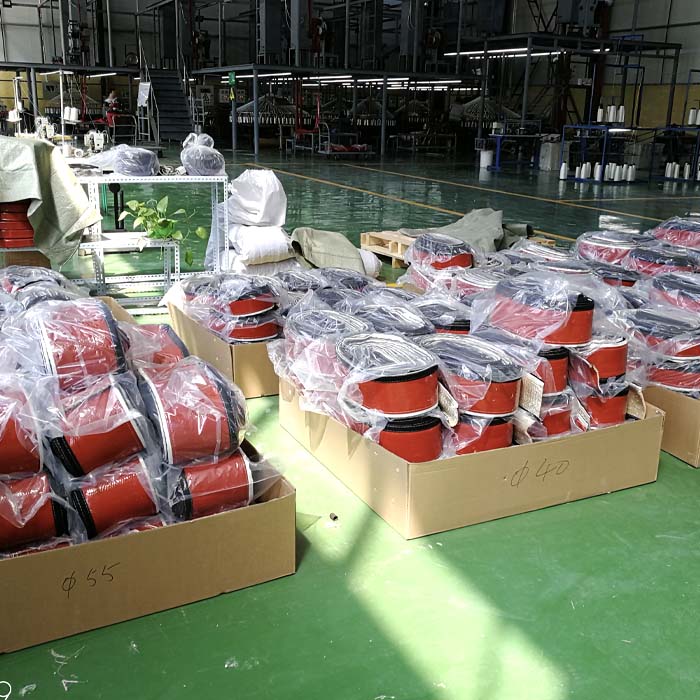Tube: Black rubber compound
Reinforcement: Multiple heavy-duty synthetic cords
Cover: Black, synthetic rubber, wrapped finished
Temperature:-40°C ~ +100°C
Application: The peristaltic pump hose is specifically engineered for application on peristaltic pumps, it is designed and manufactured for long operational life and minimized cost. It is suitable to convey various fluids, the length can be customized according to requirement. OEM and ODM is acceptable.
| Hose I.D. | Hose O.D. | Tolerance | Working Pressure | Reinforcement | Weight |
| mm | mm | mm | Bar | Ply | Kg/M |
| 13 | 31 | ±0.5 | 8 | 2 | 0.50 |
| 16 | 30 | ±0.5 | 8 | 2 | 0.70 |
| 19 | 38 | ±0.5 | 8 | 2 | 1.00 |
| 25 | 53 | ±0.5 | 16 | 4 | 2.30 |
| 32 | 61 | ±0.5 | 16 | 4 | 2.60 |
| 35 | 60 | ±0.5 | 16 | 4 | 2.40 |
| 38 | 64 | ±0.5 | 16 | 4 | 2.60 |
| 40 | 70 | ±0.5 | 16 | 4 | 4.00 |
| 51 | 81 | ±0.5 | 16 | 4 | 4.20 |
| 64 | 100 | ±0.5 | 16 | 4 | 5.20 |
| 76 | 120 | ±0.5 | 16 | 6 | 7.50 |
| 80 | 115 | ±0.5 | 16 | 6 | 6.00 |
| 102 | 144 | ±0.5 | 16 | 6 | 8.20 |
High-quality materials ensure the peristaltic concrete pump hose's durability. Resistant to abrasion and wear, extending its lifespan. Suitable for heavy-duty applications, reducing replacement frequency.
Flexible design allows for easy installation in various configurations. Compatible with a wide range of peristaltic pump models. Versatile enough to handle different fluids, chemicals, and applications.
Provides accurate and consistent flow rates, crucial in many industries. Ensures precise dosing of fluids in pharmaceutical and chemical processes. Ideal for applications requiring metering and batching of liquids.
Resistant to a wide range of chemicals, making it suitable for corrosive fluids. Maintains integrity when handling aggressive substances, ensuring safety and reliability.
Minimal maintenance requirements, saving time and costs. Resists clogging and blockages, reducing downtime. Easy to clean, enhancing operational efficiency.
Available in various sizes, lengths, and configurations to suit specific needs. Customizable to meet unique application requirements. Kingdaflex offers tailored solutions for specialized industries.
A peristaltic pump hose is a flexible tube used in peristaltic pumps. It operates by squeezing the hose with rollers or shoes to create a series of vacuum pockets, drawing in and then pushing out the fluid. This action mimics natural peristalsis.
Peristaltic pump hoses offer precise flow control, chemical resistance, durability, and resistance to contamination. They are also versatile and require minimal maintenance.
Peristaltic pump hoses are used in various industries, including pharmaceuticals, food and beverage, water treatment, chemical processing, mining, and environmental monitoring.
Consider factors such as the fluid being pumped, hose material compatibility, hose size, and application requirements. Consult the manufacturer or supplier for guidance.
Yes, peristaltic pump hoses are designed to be resistant to a wide range of chemicals, making them suitable for handling corrosive fluids.
Yes, many peristaltic pump hoses are designed to handle abrasive fluids without significant wear and tear, which is advantageous in applications like mining.
Peristaltic pump hoses have minimal maintenance requirements. They resist clogging and are easy to clean, reducing downtime and maintenance costs.
Yes, peristaltic pump hoses are suitable for hygienic applications because they prevent cross-contamination and can be cleaned easily. They are commonly used in the food and pharmaceutical industries.
Yes, peristaltic pump hoses come in various sizes, lengths, and configurations to suit different pump models and application needs. Customization options are often available.
Regularly inspect the hose for signs of wear or damage. Follow proper installation and maintenance guidelines provided by the manufacturer.
Always follow safety guidelines for the fluids being pumped. Ensure proper hose installation to prevent leaks and accidents.
Look for hoses that meet industry standards and regulatory requirements. Common certifications include FDA compliance for food applications and chemical resistance certifications for specific chemicals.
You can purchase peristaltic pump hoses from specialized hose suppliers, industrial equipment suppliers, or directly from manufacturers like Kingdaflex. Kingdaflex can offer various types of peristaltic pump hoses for your project, and welcome to contact us at any time if you are interested in.
Our factory is compounded with ISO 9001:2015 standards.
We value quality in all of our processes. We ensure that our hydraulic hoses can withstand the toughest environmental stresses.
The entire production link of our hydraulic hose takes place in our factory, to ensure the quality of each rubber tube, and a 99.99% on-time delivery rate.
If you have special requirements for the performance of rubber hose, you can contact us, we provide a variety of customized services.



